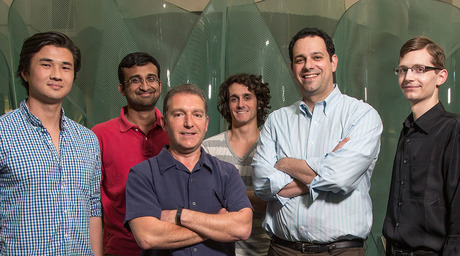Outlier enzymes play a role in metabolism and inflammation

US scientists have discovered two enzymes that appear to play a role in metabolism and inflammation — despite not bearing a resemblance to any known class of enzymes.
Writing in the journal Nature Chemical Biology, the researchers explained that their study began as an effort by Benjamin Cravatt and his team at The Scripps Research Institute (TSRI) to discover and characterise new serine/threonine hydrolases using fluorophosphonate (FP) probes — molecules that selectively bind and, in effect, label the active sites of these enzymes.
Pulling FP-binding proteins out of the entire proteome of test cells and identifying them using mass spectrometry techniques, the team matched nearly all of them to known hydrolases. The major outlier was a protein called androgen-induced gene 1 protein (AIG1); the only other one was a distant cousin in terms of sequence, a protein called ADTRP.
“Neither of these proteins had been characterised as an enzyme; in fact, there had been little functional characterisation of them at all,” said TSRI’s William H Parsons, who was co-first author of the study.
Experiments on AIG1 and ADTRP revealed that they do their enzymatic work in a unique way. Additionally, tests with panels of different enzyme inhibitors showed that AIG1 and ADTRP are moderately inhibited by inhibitors of lipases — enzymes that break down fats and other lipids.
At the same time, the Salk Institute for Biological Studies was at the time investigating a class of lipids it had discovered in 2014. Known as fatty acid esters of hydroxy fatty acids (FAHFAs), these molecules showed strong therapeutic potential. Laboratory head Alan Saghatelian and his colleagues had found that boosting the levels of one key FAHFA lipid normalises glucose levels in diabetic mice and also reduces inflammation.
“[Cravatt’s] lab was screening panels of lipids to find the ones that their new enzymes work on,” said Saghatelian, a former research associate in the Cravatt laboratory and co-senior author on the study. “We suggested they throw FAHFAs in there — and these turned out to be very good substrates.”
The Cravatt laboratory soon developed powerful inhibitors of the newly discovered enzymes and the two labs began working together, using the inhibitors and genetic techniques to explore the enzymes’ functions in vitro and in cultured cells. The team concluded that AIG1 and ADTRP, at least in the cell types tested, appear to work mainly to break down FAHFAs and not any other major class of lipid.
In principle, inhibitors of AIG1 and ADTRP could be developed into FAHFA-boosting therapies. “Our prediction,” said Saghatelian, “is that if FAHFAs do what we think they’re doing, then using an enzyme inhibitor to block their degradation would make FAHFA levels go up and should thus reduce inflammation as well as improve glucose levels and insulin sensitivity.”
The labs are now collaborating on further studies of the new enzymes — and the potential benefits of inhibiting them — in mouse models of diabetes, inflammation and autoimmune disease. The enzymes might someday be targeted with drugs to treat these disorders.
Originally published here.
Droplet microfluidics for single-cell analysis
Discover how droplet microfluidics is revolutionising single-cell analysis and selection in...
PCR alternative offers diagnostic testing in a handheld device
Researchers have developed a diagnostic platform that uses similar techniques to PCR, but within...
Urine test enables non-invasive bladder cancer detection
Researchers have developed a streamlined and simplified DNA-based urine test to improve early...




